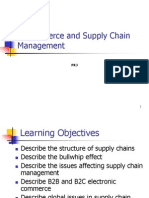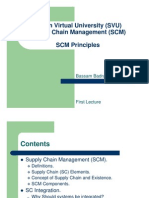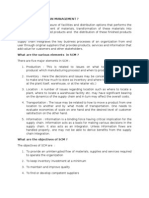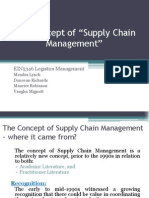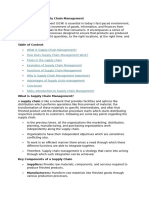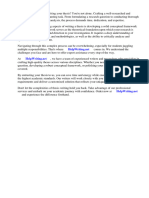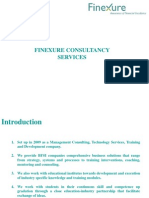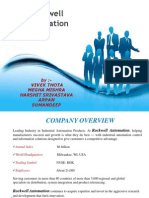Chapter9 - MGT300
Chapter9 - MGT300
Uploaded by
mussallehCopyright:
Available Formats
Chapter9 - MGT300
Chapter9 - MGT300
Uploaded by
mussallehOriginal Description:
Original Title
Copyright
Available Formats
Share this document
Did you find this document useful?
Is this content inappropriate?
Copyright:
Available Formats
Chapter9 - MGT300
Chapter9 - MGT300
Uploaded by
mussallehCopyright:
Available Formats
Chapter 9: Extending The Organization Supply Chain Management (SCM)
Learning Outcomes
Leave blank
CHAPTER 9
EXTENDING THE ORGANIZATION
SUPPLY CHAIN MANAGEMENT
Learning Outcomes
1. List and describe the components of a typical supply chain
2. Define the relationship between decision making and supply chain management 3. Describe the four changes resulting from advances in IT that are driving supply chains 4. Summarize the best practices for implementing a successful supply chain management system
1
Chapter 9: Extending The Organization Supply Chain Management (SCM)
Basics of Supply Chain
Leave blank
Supply chain management (SCM) involves the management of information flows between and among stages in a supply chain to maximize total supply chain effectiveness and profitability The supply chain has three main links: Materials flow from suppliers and their upstream suppliers at all levels Transformation of materials into semi-finished and finished products through the organizations own production process Distribution of products to customers and their downstream customers at all levels
Chapter 9: Extending The Organization Supply Chain Management (SCM)
Summary
Leave blank
List and describe the components of a typical supply chain
The components of a typical supply chain include: Suppliers supplier, Supplier, Manufacturer, Distributor, Retailer, Customer, Customers Customer
Supply Chain Management (SCM) Systems
SCM is the process of effectively managing the components of an extended value chain--from suppliers, through manufacturing and distribution chain, and to the consumers.
SCM information systems use technology to more effectively manage supply chains
Benefits of Supply Chain
Cost/ Sweater
Manufacturer
Distributor
Retailer
Customer
$48.50
Manufacturer
Retailer
Customer
$40.34
Manufacturer
Customer
$20.45
Supply Chain Management (SCM) Systems
A typical SCM system might address the following issues:
Planning Vendor selection Manufacturing Logistics Customer relationship
Supply Chain Management (SCM) Systems
Chapter 9: Extending The Organization Supply Chain Management (SCM)
Basics of Supply Chain
Leave blank
This is the strategic portion of supply chain management. A company must have a plan for managing all the resources that go toward meeting customer demand for products or services. A big piece of planning is developing a set of metrics to monitor the supply chain so that it is efficient, costs less, and delivers high quality and value to customers.
11
Chapter 9: Extending The Organization Supply Chain Management (SCM)
Basics of Supply Chain
Leave blank
Companies must carefully choose reliable suppliers that will deliver goods and services required for making products. Companies must also develop a set of pricing, delivery, and payment processes with suppliers and create metrics for monitoring and improving the relationships.
12
Chapter 9: Extending The Organization Supply Chain Management (SCM)
Basics of Supply Chain
Leave blank
This is the step where companies manufacture their products or services. This can include scheduling the activities necessary for production, testing, packaging, and preparing for delivery. This is by far the most metric-intensive portion of the supply chain, measuring quality levels, production output, and worker productivity.
13
Chapter 9: Extending The Organization Supply Chain Management (SCM)
Basics of Supply Chain
Leave blank
This step is commonly referred to as logistics. Logistics is the set of processes that plans for and controls the efficient and effective transportation and storage of supplies from suppliers to customers. During this step, companies must be able to receive orders from customers, fulfill the orders via a network of warehouses, pick transportation companies to deliver the products, and implement a billing and invoicing system to facilitate payments.
14
Chapter 9: Extending The Organization Supply Chain Management (SCM)
Basics of Supply Chain
Leave blank
This is typically the most problematic step in the supply chain. Companies must create a network for receiving defective and excess products and support customers who have problems with delivered products.
15
Chapter 9: Extending The Organization Supply Chain Management (SCM)
Information Technologys Role in the Supply Chain
Leave blank
ITs primary role is to create integrations or tight process and information linkages between functions within a firm
16
Chapter 9: Extending The Organization Supply Chain Management (SCM)
Information Technologys Role in the Supply Chain
Leave blank
more visible models of different ways to do things in the supply chain have emerged. High visibility in the supply chain is changing industries
Factors Driving SCM
companies must respond to demanding customers through supply chain enhancements
increased competition makes any organization that is ignoring its supply chain at risk of becoming obsolete
Supply Chain Management
as the pace of business increases through electronic media, an organization's supply chain must respond efficiently, accurately, and quickly
17
The functions or roles of information technology in the supply chain management:
1.Visibility. supply chain visibility is the ability to view all areas up and down the supply chain.
2. Consumer behavior. companies can respond more faster and more effectively to consumer demands through supply chain enhances.
18
3. Competition. the method that been used by IT in order to bring competition advantage:
Supply chain planning (SCP) software - advanced mathematical algorithms. - Use mathematical models to predict inventory level based on the efficient flow of resources into the supply chain.
Supply chain execution (SCE) software - automates the different steps and stages of the supply chain. - e.g : automatically sending purchase orders to vendors when inventories reach specified levels
19
4. Speed. by IT, supply chain management can gain the 'speed'.
Factors fostering supply chain speed: 1. Pleasing customers has become something of a corporate obsession. 2. Information is crucial to managers abilities to reduce inventory and human resource requirements to a competitive level. 3. Information flows are essential to strategic planning for and deployment of resources.
20
Chapter 9: Extending The Organization Supply Chain Management (SCM)
Information Technologys Role in the Supply Chain
Leave blank
Supply chain visibility the ability to view all areas up and down the supply chain Bullwhip effect occurs when distorted product demand information passes from one entity to the next throughout the supply chain
Visibility
To explain the bullwhip effect, discuss a product that demand does not change, such as diapers. The need for diapers is constant, it does not increase at Christmas or in the summer, diapers are in demand all year long. The number of newborn babies determines diaper demand, and that number is constant. Retailers order diapers from distributors when their inventory level falls below a certain level, they might order a few extra just to be safe Distributors order diapers from manufacturers when their inventory level falls below a certain level, they might order a few extra just to be safe Manufacturers order diapers from suppliers when their inventory level falls below a certain level, they might order a few extra just to be safe
Eventually the one or two extra boxes ordered from a few retailers becomes several thousand boxes for the manufacturer. This is the bullwhip effect, a small ripple at one end makes a large 21 wave at the other end of the whip.
Chapter 9: Extending The Organization Supply Chain Management (SCM)
Information Technologys Role in the Supply Chain
Leave blank
Consumer Behavior
Companies can respond faster and more effectively to consumer demands through supply chain enhances Demand planning software generates demand forecasts using statistical tools and forecasting techniques
22
Chapter 9: Extending The Organization Supply Chain Management (SCM)
Information Technologys Role in the Supply Chain
Leave blank
Competition
Supply chain planning (SCP) software uses advanced mathematical algorithms to improve the flow and efficiency of the supply chain SCP depends entirely on information for its accuracy Supply chain execution (SCE) software automates the different steps and stages of the supply chain SCE can be as simple as electronically routing orders from a manufacturer to a supplier
SCP and SCE both increase a companys ability to compete
23
Chapter 9: Extending The Organization Supply Chain Management (SCM)
Information Technologys Role in the Supply Chain
Leave blank
Three factors fostering speed:Speed
24
Chapter 9: Extending The Organization Supply Chain Management (SCM)
Supply Chain Management Success Factors
Leave blank
25
Chapter 9: Extending The Organization Supply Chain Management (SCM)
Supply Chain Management Success Factors
Leave blank
Supply Chain Management Success Factors
1. Make the sale to suppliers A large part of any SCM system extends beyond the organization to the suppliers. Since the organization has very little control over anything external to itself, these pieces are typically the most complicated to build, develop, and implement. Be sure suppliers are on board with the benefits that the SCM system will provide to ease SCM implementation difficulties 2. Wean employees off traditional business practices If the organization cannot convince people that using the SCM software is worthwhile, the employees will probably find a way to continue performing their job without using the software
26
Chapter 9: Extending The Organization Supply Chain Management (SCM)
Supply Chain Management Success Factors
Leave blank
Supply Chain Management Success Factors
3. Ensure the SCM system supports the organizational goals Be sure to se`lect SCM software that supports organizational goals and strategies
4. Deploy in incremental phases and measure and communicate success
Designing the deployment of the SCM system in incremental phases is the most successful deployment method.
The BIG BANG approach implementing everything all at once fails 90 percent of the time
5. Be future oriented An SCM system, like all systems, must scale to meet future demands
27
Chapter 9: Extending The Organization Supply Chain Management (SCM)
SCM Success Stories
Leave blank
Top reasons why more and more executives are turning to SCM to manage their extended enterprises
28
Chapter 9: Extending The Organization Supply Chain Management (SCM)
Summary
Leave blank
Define the relationship between decision making and supply chain management
SCM enhances decision making. Collecting, analyzing, and distributing transactional information to all relevant parties, SCM systems help all the different entities in the supply chain work together more effectively. SCM systems provide dynamic holistic views of organizations. Users can drill down into detailed analyses of supply chain activities in a process analogous to DSS. Without SCM systems, organizations would be unable to make accurate and timely decisions regarding their supply chain
29
Chapter 9: Extending The Organization Supply Chain Management (SCM)
Summary
Leave blank
Describe the four changes resulting from advances in IT that are driving supply chains
Although people have been talking about the integrated supply chain for a long time, it has only been recently that advances in information technology have made it possible to bring the idea to life and truly integrate the supply chain. Visibility, consumer behavior, competition, and speed are a few of the changes resulting from advances in information technology that are driving supply chains
30
Chapter 9: Extending The Organization Supply Chain Management (SCM)
Summary
Leave blank
Make the sale to suppliers
Wean employees off traditional business practices Ensure the SCM system supports the organizational goals Deploy in incremental phases and measure and communicate success Be future oriented
Summarize the best practices for implementing a successful SCM system
31
You might also like
- Supply Chain Management of Coca-ColaDocument20 pagesSupply Chain Management of Coca-ColaAditya Dethe85% (33)
- Study of Supply Chain Management at Britannia Industries.Document95 pagesStudy of Supply Chain Management at Britannia Industries.Satender Kumar75% (8)
- Supply Chain 4.0: From Stocking Shelves to Running the World Fuelled by Industry 4.0From EverandSupply Chain 4.0: From Stocking Shelves to Running the World Fuelled by Industry 4.0Rating: 3 out of 5 stars3/5 (1)
- Business Plan of Coconut WaterDocument9 pagesBusiness Plan of Coconut Waterchmon75% (4)
- Green Bay East Deca Community Service Project ManualDocument28 pagesGreen Bay East Deca Community Service Project Manualapi-199680997No ratings yet
- Lean Six Sigma Project Charter TemplateDocument4 pagesLean Six Sigma Project Charter TemplateSteven Bonacorsi75% (4)
- Chapter 10Document25 pagesChapter 10Nur syafiqah NabihahNo ratings yet
- Extending The Organization - Supply Chain Management (SCM)Document35 pagesExtending The Organization - Supply Chain Management (SCM)rizcst9759No ratings yet
- Supply Chain Management: Zia Shaukat Nisar Ahmed Nisar Najam-Us SaqibDocument26 pagesSupply Chain Management: Zia Shaukat Nisar Ahmed Nisar Najam-Us SaqibNisar Ahmed NisarNo ratings yet
- Extending The Organization - Supply Chain ManagementDocument24 pagesExtending The Organization - Supply Chain ManagementShuhaime IshakNo ratings yet
- Lifeline - Supply ChainDocument41 pagesLifeline - Supply Chainvnewaskar_1100% (1)
- Mr. Thilak RajanDocument22 pagesMr. Thilak Rajanmreka5929No ratings yet
- Chapter 1 For 2nd Yr Evolution of Supply ChainDocument25 pagesChapter 1 For 2nd Yr Evolution of Supply Chaintsion alemayehuNo ratings yet
- 1.0 Introduction To Supply Chain Management (SCM)Document69 pages1.0 Introduction To Supply Chain Management (SCM)Anchal BaggaNo ratings yet
- Supply Chain Management: A Seminar Report OnDocument24 pagesSupply Chain Management: A Seminar Report OnCA OceanNo ratings yet
- Assignment SCMDocument12 pagesAssignment SCMnaziaNo ratings yet
- Understanding The Supply ChainDocument25 pagesUnderstanding The Supply Chaintipu azizNo ratings yet
- Supply Chain Information TechnologyDocument23 pagesSupply Chain Information TechnologyBusiness Expert Press100% (23)
- Extending The Organization - Supply Chain ManagementDocument21 pagesExtending The Organization - Supply Chain ManagementThao TrungNo ratings yet
- Unit II SCM MBADocument52 pagesUnit II SCM MBARaghav SharmaNo ratings yet
- Rahul Final Project Final PDFDocument72 pagesRahul Final Project Final PDFNandan KesariNo ratings yet
- C1 IntroductionDocument5 pagesC1 IntroductionGovind UNo ratings yet
- Indroduction To Supply Chain 1Document38 pagesIndroduction To Supply Chain 1Tansen John100% (2)
- W11- Apparel Merchandising and SourcingDocument25 pagesW11- Apparel Merchandising and SourcingM Ali NoraniNo ratings yet
- SCLM Notes 19Document90 pagesSCLM Notes 19Prateek DixitNo ratings yet
- Supply Chain Management: Powerpoint By: Ray A. Decormier, Ph.D. Central Connecticut State UniversityDocument62 pagesSupply Chain Management: Powerpoint By: Ray A. Decormier, Ph.D. Central Connecticut State UniversityAntony LawrenceNo ratings yet
- Global Supply-Chain Management Prof. Sameer MathurDocument38 pagesGlobal Supply-Chain Management Prof. Sameer MathurRaja NarenNo ratings yet
- Engineering Management: Presented byDocument30 pagesEngineering Management: Presented byfatimaNo ratings yet
- SCM_ Quality etc PRODUCTION AND OPERATIONS MANAGEMENTDocument62 pagesSCM_ Quality etc PRODUCTION AND OPERATIONS MANAGEMENTKulgeet TanyaNo ratings yet
- MIS FinalDocument18 pagesMIS Finaltahsinahmed9462No ratings yet
- Supply Chain ManagementDocument81 pagesSupply Chain ManagementMOHD.ARISH100% (1)
- Mba Supply Chain Management ReportDocument24 pagesMba Supply Chain Management ReportRijana ShresthaNo ratings yet
- E-Commerce and Supply Chain ManagementDocument41 pagesE-Commerce and Supply Chain ManagementRogil Jacob DanielNo ratings yet
- SCM PrinciplesDocument35 pagesSCM PrinciplesSRanizaiNo ratings yet
- Supply Chain Management Training Kit v5.0Document59 pagesSupply Chain Management Training Kit v5.0Ajay ThakralNo ratings yet
- SCM Unit 1Document43 pagesSCM Unit 1rpulgam09No ratings yet
- What Is Supply Chain Management ?Document5 pagesWhat Is Supply Chain Management ?mushtak123No ratings yet
- Operation and Supply Chain Strategies - Kumar AnimeshDocument6 pagesOperation and Supply Chain Strategies - Kumar Animeshkumaranimesh2606No ratings yet
- Kuliah 2 Basics of SCMDocument21 pagesKuliah 2 Basics of SCMJaka SeptiadiNo ratings yet
- Supply Chain ManagementDocument26 pagesSupply Chain Managementzahid_497No ratings yet
- CHAPTER 10 Supply Chain ManagementDocument12 pagesCHAPTER 10 Supply Chain ManagementMuhammad AsyrafNo ratings yet
- Supply Chain Management: Department of Agribusiness ManagementDocument19 pagesSupply Chain Management: Department of Agribusiness Managementjmbn bandaraNo ratings yet
- Chapter 6 Digital BusinessDocument20 pagesChapter 6 Digital BusinessNwe Nwe SoeNo ratings yet
- Britinia Industries Case Study.Document95 pagesBritinia Industries Case Study.PrajaktaNo ratings yet
- SCM - An OverviewDocument50 pagesSCM - An OverviewPooja NagleNo ratings yet
- Supply Chain ManagementDocument2 pagesSupply Chain ManagementMahesh JayawardanaNo ratings yet
- Ome752 Supply Chain Management Unit - I IntroductionDocument21 pagesOme752 Supply Chain Management Unit - I Introductionjeeva santhiyaNo ratings yet
- Supply Chain PresentationDocument43 pagesSupply Chain Presentationanithavarghese73058100% (1)
- Introduction To Supply Chain ManagementDocument19 pagesIntroduction To Supply Chain ManagementSneha Karpe100% (1)
- VALUE-CHAIN-AND-SUPPLY-CHAIN-_20241025_093359_0000Document26 pagesVALUE-CHAIN-AND-SUPPLY-CHAIN-_20241025_093359_0000Rubie Ann PaoNo ratings yet
- Aditonal Notes - 1Document8 pagesAditonal Notes - 1yeteday615No ratings yet
- U1 S3Document12 pagesU1 S3MahfuzNo ratings yet
- IT in Supply Chain ManagementDocument62 pagesIT in Supply Chain Managementrohitsingh17No ratings yet
- SCM Lecture FinalDocument60 pagesSCM Lecture FinalFariha Ansari0% (1)
- Introduction to Supply Chain ManagementDocument5 pagesIntroduction to Supply Chain Managementmeghnadevi1234No ratings yet
- Lecture Week 08 ICT100Document41 pagesLecture Week 08 ICT100kecifin263No ratings yet
- Supply Chain Management ProjectDocument22 pagesSupply Chain Management ProjectYogita NarangNo ratings yet
- Understanding The Supply ChainDocument32 pagesUnderstanding The Supply ChainAnshul NataniNo ratings yet
- Supply Chain Concepts Unit 1Document32 pagesSupply Chain Concepts Unit 1UP 16 GhaziabadNo ratings yet
- Supply Chain Business Startup Guide: Step-by-Step Tips for SuccessFrom EverandSupply Chain Business Startup Guide: Step-by-Step Tips for SuccessNo ratings yet
- MANAGEMENT AND Operations by Haroon AkramDocument24 pagesMANAGEMENT AND Operations by Haroon Akramharoon100% (2)
- Kiriwasco VacanciesDocument4 pagesKiriwasco VacanciesGovernor Joseph NdathiNo ratings yet
- Conceptual Framework of The Study ThesisDocument8 pagesConceptual Framework of The Study Thesiskarengilchristsiouxfalls100% (2)
- MES Soft Skills3Document20 pagesMES Soft Skills3Sankar SpNo ratings yet
- Robin Hambleton Elected Mayor Presentation 111128Document24 pagesRobin Hambleton Elected Mayor Presentation 111128andrew_kelly1354No ratings yet
- Om - IDocument4 pagesOm - IPradosh Ranjan JenaNo ratings yet
- Accenture Embedding Operational Risk Appetite Framework in Decision Making Large European BankDocument4 pagesAccenture Embedding Operational Risk Appetite Framework in Decision Making Large European Bankvandana005No ratings yet
- Assessing The Learning Action Cell PDFDocument5 pagesAssessing The Learning Action Cell PDFMillet SantosNo ratings yet
- Chapter 3 TQMDocument22 pagesChapter 3 TQMSadiya abdullahNo ratings yet
- Preceptor GuidelinesDocument16 pagesPreceptor GuidelinesAryn Phillips100% (3)
- Strategic Management AccountingDocument13 pagesStrategic Management AccountingloungouNo ratings yet
- Spring 2020 Chronicle Books Frontlist CatalogDocument180 pagesSpring 2020 Chronicle Books Frontlist CatalogChronicleBooks67% (3)
- Literature Review Quality in Teacher Professional DevelopmentDocument20 pagesLiterature Review Quality in Teacher Professional DevelopmentaspiredNo ratings yet
- Work Experience DocfDocument19 pagesWork Experience DocfmeriemNo ratings yet
- Dutton & Ragins 2007 - Exploring Positive Relations at WorkDocument92 pagesDutton & Ragins 2007 - Exploring Positive Relations at WorkmedularagenciaNo ratings yet
- HRM351 - Performance AppraisalDocument28 pagesHRM351 - Performance AppraisalAndrea Lộc Thảo NguyênNo ratings yet
- Finexure Consultancy ServicesDocument15 pagesFinexure Consultancy ServicesTarun Kumar SinghNo ratings yet
- ServiceNow Whitepaper ITIL4 PoV 102519Document8 pagesServiceNow Whitepaper ITIL4 PoV 102519Atulay Mahajan100% (1)
- MISDocument13 pagesMISVivek ThotaNo ratings yet
- CH 6Document34 pagesCH 6k61.2214535043No ratings yet
- The 21 Irrefutable Laws of LeadershipDocument16 pagesThe 21 Irrefutable Laws of LeadershipUgnė NorvilaitėNo ratings yet
- Handbook of Medical Leadership and Management Paula Murphy download pdfDocument51 pagesHandbook of Medical Leadership and Management Paula Murphy download pdfpealsheikefx100% (2)
- Module 10 - Implementing Strategy Budgets, Policies, Best Practices, Support Systems, and RewardsDocument34 pagesModule 10 - Implementing Strategy Budgets, Policies, Best Practices, Support Systems, and Rewardshyrald100% (1)
- 03 Supply Chain StrategyDocument21 pages03 Supply Chain StrategyOmnia HassanNo ratings yet
- Officers DirectorsDocument1 pageOfficers DirectorsVon Andrei MedinaNo ratings yet
- Strategic Human Resource Management in Small and Growing Firms: Aligning Valuable ResourcesDocument22 pagesStrategic Human Resource Management in Small and Growing Firms: Aligning Valuable ResourcesFadzlli AminNo ratings yet
- 9 e Daft Chapter 6Document22 pages9 e Daft Chapter 6GabNo ratings yet
































